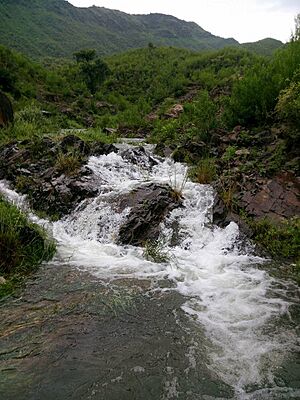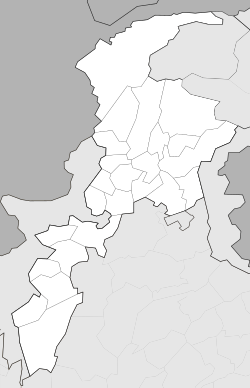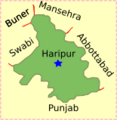Haripur, Pakistan facts for kids
Quick facts for kids
Haripur
ہری پور
|
|
|---|---|
|
City
|
|

Small Waterfall in Haripur City
|
|
| Country | |
| Province | Khyber Pakhtunkhwa |
| District | Haripur |
| Elevation | 520 m (1,710 ft) |
| Population
(2017)
|
|
| • Total | 85,739 |
| Time zone | UTC+5 (PST) |
| Calling code | 0995 |
| Number of Union councils | 45 |
Haripur is a city in Pakistan. It is located in the Khyber Pakhtunkhwa province. Haripur is one of the largest cities in the province by population. It is also the main city for its district, which is also called Haripur.
The city is about 65 kilometers (40 miles) north of Islamabad, Pakistan's capital. It is also 35 kilometers (22 miles) south of Abbottabad. Haripur is in a hilly area, about 520 meters (1,706 feet) above sea level.
Contents
History of Haripur
Haripur was founded in 1822 by Hari Singh Nalwa. He was a brave commander for Ranjit Singh, a powerful Sikh ruler. The city became the main center for the Hazara region until 1848.
In 1846, the British East India Company took control of Haripur. This happened after the Sikhs were defeated in a war. An important monument in the city marks the grave of Colonel Canara. He was a European officer who bravely defended his guns in 1848.
The British divided the Hazara region into three smaller areas called tehsils. These were Mansehra, Abbottabad, and Haripur. The Hazara region was part of the British Punjab province until 1901. Then, it became part of a new province called the North-West Frontier Province.
During the time of British rule, Haripur was a small town. In 1851, a special army unit was formed in Haripur. It was called the 4th (Hazara) Mountain Battery. Local gunners from Hazara were trained by a British officer named James Abbott. This unit helped defend the district and fought in many campaigns.
After Pakistan became an independent country in 1947, the Hazara district grew. In 1976, it became a larger division. Later, Haripur Tehsil was made into its own district, and Haripur city became its main headquarters.
Education in Haripur
Haripur has good educational facilities. It is home to the University of Haripur. Several colleges are connected to this university. There is also a special institute called the Pak-Austria Fachhochschule: Institute of Applied Sciences and Technology. These places help students learn many different subjects.
Population and People
Haripur is home to many people. In 2017, the city's population was about 133,100. Most people in Haripur follow the religion of Islam. There are also smaller groups of people who follow other religions, like Christianity and Hinduism.
Climate and Weather
The weather in Haripur usually has warm temperatures. Rain is spread out fairly evenly throughout the year. This type of weather is known as a "humid subtropical climate". It means the city has warm, humid summers and mild winters.
| Climate data for Haripur, Pakistan | |||||||||||||
|---|---|---|---|---|---|---|---|---|---|---|---|---|---|
| Month | Jan | Feb | Mar | Apr | May | Jun | Jul | Aug | Sep | Oct | Nov | Dec | Year |
| Mean daily maximum °C (°F) | 17 (62) |
18 (64) |
23 (73) |
28 (82) |
34 (93) |
39 (102) |
37 (98) |
34 (93) |
33 (91) |
30 (86) |
24 (75) |
19 (66) |
28 (82) |
| Mean daily minimum °C (°F) | 3 (37) |
5 (41) |
10 (50) |
14 (57) |
18 (64) |
24 (75) |
24 (75) |
23 (73) |
20 (68) |
14 (57) |
9 (48) |
4 (39) |
14 (57) |
| Average precipitation mm (inches) | 74 (2.9) |
100 (4.1) |
120 (4.9) |
100 (4.1) |
74 (2.9) |
76 (3) |
250 (9.7) |
240 (9.6) |
97 (3.8) |
51 (2) |
30 (1.2) |
48 (1.9) |
1,260 (50.1) |
| Source: Weatherbase | |||||||||||||
Famous People from Haripur
Many notable people have come from Haripur, including:
- Ayub Khan, a former President of Pakistan
- Qateel Shifai, a well-known Urdu poet and lyricist
- Sohail Akhtar, a Pakistani cricketer
- Ali Azmat, a popular Pakistani pop singer
- Allama Syed Jawad Naqvi, an Islamic scholar
- Omar Ayub Khan, a politician
- Raja Sikander Zaman, a former Chief Minister
- Anwar Shamim, an Air Marshal
- Pir Sabir Shah, a former Chief Minister
Images for kids
See also
 In Spanish: Haripur para niños
In Spanish: Haripur para niños





